|
Movement I
Listeners accustomed to the
modern technique of recording generally do not understand why Toscanini
insisted so persistently on the dampened, echo-less acoustics of NBC’s
Studio 8H. (Toscanini’s will continued to prevail in the early 1950’s,
when one of the record company’s engineers wanted, in the interest of ‘euphony’,
to touch up his Beethoven recordings with artificial reverberations. The
records had to be called back). His justification for this almost qualifies
as an artistic confession. He was only willing to work under such acoustic
conditions in which every element of the music was ‘clearly audible’. It
is no coincidence that Bruno Walter chose an echoing riding school for
the scene of his later recordings, the reverberating sounds of which embraced
the orchestra with soft and even euphony. For Bruno Walter worked with
a broad brush, while Toscanini drew with a sharp steel blade. Walter’s
recordings were like an impressionistic photograph, prepared with the help
of a ‘blurring lens’, whereas in Toscanini’s recordings even the finest
details must be seen clearly. He put reality of feeling and exactness of
form before aurally gratifying euphony. It is interesting that even a mediocre
record-player gives a more or less acceptable picture of the Olympian proportions
of Klemperer’s rhythms, Furtwängler’s demonic dynamics or Bruno Walter’s
dreamlike agogics, because the changes in the acoustical sphere – the musical
character changes – take place relatively slowly, allowing our ears
to follow them more easily. It is not so with Toscanini. If, as a result
of weakness in the playing-back of sounds, the infinitely nuanced drawing
of the musical formation becomes blurred, the musical intentions will,
together with it, also remain in obscurity. Just as Leonardo’s Mona-Lisa
would lose its magic if we were to know it from a picture in a daily paper,
a mediocre musical reproduction is unable to represent Toscanini’s ideas.
The tangible perceivability of the instruments and the clear soundscape
were for him the essentials of every musical performance.
He was well aware of the
reasons. His musical dramaturgy, one of the most characteristic traits
of his orchestral art, was realized by the qualitative changes in
the tone. (However unbelievable this may seem: in the case of an ideal
reproduction, next to the tone of the Toscanini-orchestra, recordings prepared
using a much more advanced procedure seem also to be more monotone – they
awaken a more one-sided impression.) There was hardly anyone among his
contemporaries who was more perceptive of the form of the music in the
momentary transformations of timbre, or who would have attached so much
importance to the difference between quantitative and qualitative elements
of expression; that is to say, between dynamics and color.
Perhaps no one knew better than him the value of the moment (or
rather the value of the event that occurs at that moment). The meaning
of tonal colors; their rapid changes similar to human speech – if one may
say, the ‘articulation’ of color – formed the basis of his musical phraseology.
He demanded the same of his players, just as he demanded perfectly clear
diction from his singers.
The clarity of the ‘consonants
and vowels’ of the orchestral timbre – the volubility of the tonal picture
– appears immediately in the signature theme of the symphony that
we are to examine: Toscanini shades the initial a-e step of the
oboe with no less than four timbre changes. We should rather write the
smooth half-notes of the motive as:

Neither the resonant background
of the short forte and long piano chords nor the motivic
inversion (the reflection of the fourth) alone gives the reason for the
unveiling of the ‘active’ and ‘passive’ face of the pair of bars – the
reason lies much deeper. This must be approached through a bit of a detour.
The basic form of a classical
melody, as we know, is the period – the melody usually falls symmetrically
into 2+2, 4+4 and 8+8 bars. (To the ‘question’ of the first two bars, the
subsequent two bars give an ‘answer’, the thus unified four bars can nevertheless
be seen as a single question, to which bars 5–8 now give an answer. The
form continues to develop in a similar manner: the eight bar period ends
in a half cadence and rhymes with the resolution – the authentic cadence
– of the sixteen bar period.)
There is, however, a characteristic
and frequent type of melody found in Haydn, Mozart and Beethoven that allows
a deeper view of the proportional laws of the classical theme. (One is
amazed that the following order has thus far escaped the notice of musicologists.)
In the characterization of
this type of melody, we must view as the ‘unit of measurement’ that meter
in which we should have to conduct the melody (or in which an ideal conductor
would conduct it). The smallest motivic component comprises four beats
arranged in such a manner that the tension point 2)
touches the beginning of the second beat, which means that this tension
point actually appears in order to determine the value of the ‘unit
of measurement’:

There is no more need to
determine the value of the ‘unit of measurement’ in the following four-beat
group – the place of the tension point shifts. Not one, but two
units of time elapse before it reappears, since the form itself has grown
twofold:

The melody continues to develop
logically along the same principle: a newer 8 beats answers the already
measured 8 beats, meaning that we must now take a four-step, rather
than a two-step path to the tension point:

For the sake of completeness,
let us also cite a period consisting of 32 units of measurement. In the
second half of the melody, as expected, not four, but eight units
of value determine the position of the tension point (indeed, after the
unchanging repetition of bars 1–4, something new occurs in the 13th
bar of the second half period):
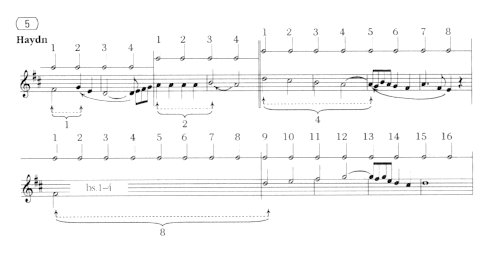
In summary, along with the
periodic growth of the melody (4–8–16–32), the tension point also undergoes
a gradual shift (by 1–2–4–8 units).
The extent to which the dynamic
qualities of this theme structure can be used to create tension is shown
by the following two examples of intensification from the 1st
movement in Toscanini’s recording 3):
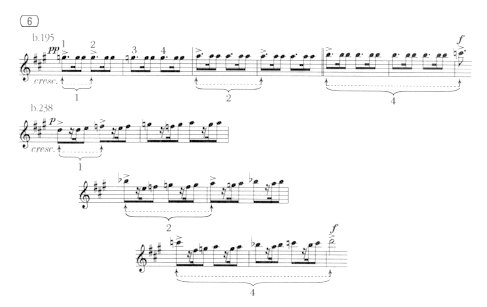
Returning now to our starting
point, let us prepare an ‘electrocardiogram’ of bars 1–2 by breaking down
the dynamic and color components of the sound:

What is happening on the
second eighth? The oboe’s sound throbs with pain after the forte
stroke and the short, whip-cracking chord of the orchestra. The opposite
can be seen, on the other hand, from the last fourth of the bar: the oboe’s
timbre changes captivatingly (a touch of bliss is concealed in that change),
as if the performer had changed unnoticed to a softer-colored instrument,
thus preparing the easing of the second bar. The splendor (I cannot find
a better word for this) that accompanies this relaxation is the first great
event of the performance. It is also the first lesson, for we buy this
event at a price: the first bar’s burst of pain makes the relaxation of
the second bar possible. It is just the unity of the principles
of tension and joy that preserves this event from all elements of romantic
eroticism.
In the two Haydn excerpts
we can observe that the tension point ‘steps out’ from the preceding events
and connects to the consequent element of the motive:

(that is to say, it is not
so much with the antecedent, but rather with the consequent that the tension
point forms a magnetic unit). For this reason we divided our signature
theme into two layers. We must imagine the timbre changes of the second
eighth and the fourth quarter as if new instruments were stepping out of
the score and were melodically stringing the melody line to the next
note (see the arrows of Fig. 7).
The relaxed state of the
melody (in the middle of bar 2) multiplies the intensity of the forte
shaking that follows. It is thus that this music born of explosions
results in Beethoven’s most effective ‘music of creation’, or musica in
nascendi. According to Toscanini’s interpretation, the melody must cry
out with pain because the forte shaking has woken it from some kind of
sleep beyond dreams, and when it wishes to slip back into unconsciousness,
the stroke repeats itself again and again in order to prod the melody back
to life. This is the deeper meaning of the tension and absence of
tension in the theme. It is in this birthing-thought, however, that Toscanini’s
interpretation (not only here, but also in the case of the second theme)
strays from the traditional understanding, which holds – and here we can
quote Schumann – that this introduction ‘announces the celebration’. Toscanini
lives through every pain and jolt of birth in contrast to his usual, ceremonial
intonation 4).
Nevertheless, bar 7 is the
real touchstone of the musical logic that nearly mirrors natural laws;
it is the breakwater of the structure 5).
The basic rule of this style of expression is that on ‘this’ and on the
‘other’ side of the peak, inverted regularities and opposing attractions
in form become valid. (Toscanini is also justified by the outward appearance
of the score, since the relation between the ‘active’ odd and the ‘passive’
even measures reverses in bars 9–14). After the breakwater of bar
7, bar 8, rather than being eased, is made more and more troubled. Yet
after the gradually heavier-growing chords of the strings 6),
a momentary breath enters, and in the place of the earlier explosions
(in the odd bar 9), there follows the s o l u t i o n. I would like to
express here the true, living significance of this concept that has become
clichéd over the course of time: the fundamental point of Toscanini’s
‘ars poetica’ may be that there are no empty, worn-out modes of expression
and faded or threadbare musical clichés – the creative power is
enthralling in the way that each of the seemingly cooled musical formulas
is brought to new life, returning the phrases that have become conventional
to their original, untamed raw and powerful states. In bar 9, the heartbeat
of the music stops at a motion from Toscanini, and an indescribable easing
spreads over our ‘limbs’. There is no such Tristan-like softening; no romantic
appeal to death (‘ancestral oblivion’) 7),
that could attain this point with such an effect. Toscanini, however, as
we have said, knows the value of the ‘moment’: the easing only lasts for
a few moments so that subsequently a light cloud arises from it in bar
10 8).
After the condensed action
of the opening measures, bars 15–22 build with monumental rocks. The chords
of the wind instruments, as the score also shows, create a cohesive
force between the odd and the even bars. The sustained chords of the odd
bars strain towards the muffled beats of the even bars. The difference
between, on the one hand the sustained, tense character, and on
the other hand, the beat-like, explosive character of the intonation
(that is, of the ‘linear’ and the ‘partitioning’ elements) will be one
of the key questions of our stylistic examination. Only the slower tempo
differentiates bars 34–41 from the earlier fortissimo section: the wilfully
shortened endings – ‘fist-raisings’ – of bars 34–36–38 plunge into bars
35–37–39 with a dull beat.
In the last bars of the fortissimo
blocks (bars 22 and 41) this anger ‘evaporates’ without a trace. The staccatos
of the scale motive are airily and nimbly becoming light (like at bar 10)
and are flung into a weightless state. This is already the forest of Ariel
and Puck, and this evocation of a ‘fairyland’ belongs among the most enticing
of Toscanini’s ‘pleasurable experiences’. It is as if the glittering incorporeality
and weightlessness were that dimension, in which his lively spirit flutters
around the most at home. In fact, this scale motive could serve as an example
that one single, seemingly unimportant difference in phrasing can change
the entire order of the elements of form. According to the conventional
understanding, the new melody is born in bar 23, while in Toscanini’s
interpretation, it arises four sixteenths earlier. Thus the scale motive
can rush into bar 23 with a single swoop, and the half note (f)
pops up unexpectedly in front of us ‘in amazement’ – not in ‘emotional’
tension, but rather in ‘sensuous’ color.
Incidentally, three short
remarks will be inserted here:
1. The oboe melody begins in the score as well with four sixteenths run
(see Fig. 9).
2. The 4 sixteenths lead (in the violins) at the end of bar 28 fully supports
Toscanini, making an appearance with similar logic.

3. We also receive an answer
as to why Toscanini exposed the analogous sixteenths in bar 9 so resolutely
(to which the playful decrescendo of the peak of the scale effectively
replied):

As we mentioned, the maestro
also places the second theme in the service of the ‘birthing’ thought,
and thus tears himself fundamentally even further from the conventional
conception. After the intensely singing, melodically saturated odd bars
(23, 25), almost every conductor would handle the even bars (24, 26) merely
as minor components or afterthoughts, with the help of which the motif’s
form can be rounded off. Toscanini, however, on the basis of the score,
restores the melody’s original accentuation; that is, facing the passive-sensuous
magic of the first bar, he restores to right the active-rhythmical
tension of the second bar:

In fact, Beethoven also does
this when he emphasizes the characteristic rhythms of the even bars,
in order to make them distinct in the ostinato of the viola (these are
made even more contoured in bars 43 and 45). With this Toscanini unveils
one of the most important motifs of the introduction: in that rhythm lies
the basic motion – the basic rhythm – of the composition, which
follows through the four movements of the symphony (cf. Fig. 106). It means
nothing less than that in this rhythmic motion we can observe moments of
the conception of the piece. Toscanini’s interpretation compellingly desires
that we imagine the rhythm of the Vivace next to this rhythm:

The two rhythms relate to
each other as if they were of the same thought; as if the two facades
of night and day, underground and above ground – Hades and Olympus – were
to face each other. The two formulas are mirror images of each other 9),
and this duality unfailingly affects us like the basic motion’s ‘prenatal’
and ‘postnatal’ form – a latent ‘Hades’ and a sun-flooded ‘Olympus’. (In
bars 60–66, with the metamorphosis of the rhythm, we can peek at the moment
of birth.)
With this interpretation,
namely, with the activation of the even bars, Toscanini creates order in
a different sense, too. This motion (bar 24) is no other than the continuation
of the symphony’s signature theme – the opening theme. The opening
theme connects a downward and an upward stepping motion to each other (a-e
and c# -f#). The above mentioned motion merely changes the elements
of the melody:

The interval of the fourth
(at the end of the motive) becomes so expressive with Toscanini, because
it rhymes in a natural manner with the opening step of the symphony. 10)
(This is caused by the sudden ‘burst’ of the c-g melody arch of
bar 24 and the gesticulating effect of the condensed rest after the 2nd
quarter, together with the suddenly high-leaping g-c fourth’s sharp rhythm).
That Beethoven also intends such a role for it is evident from bar 28,
where, almost as the ‘punch-line’ of the theme, this fourth interval steps
forward unexpectedly in the violins. Our recording illuminates this moment
with exceptional sharpness 11).
Behold! What complications
and ramifications there are that Toscanini simply calls ‘faithfulness
to the score’. However, it contains no fewer problems than the formation
of the opening bars of the theme.
In contrast to that intractable
opinion that Beethoven’s works can necessarily only be properly interpreted
by German conductors, we must assert the counterexample – that German conductors
frequently misinterpret the French influences that crop up all over in
Beethoven’s music, such as sensuous-color elements, acoustic effects, and
elements of intonation. The French influence accompanied Beethoven through
his entire life. Early on he became acquainted with the works of Méhul,
Dalayrac, Grétry, Gossec, Kreutzer, Gaveau and Monsigny. Moreover,
he considered Cherubini, and not Mozart, to be the greatest opera composer
of the age (he heard some seven of Cherubini’s operas and took notes for
himself on some of the scenes of The Water Carrier). He employs
the French influence, for instance, in the harp in the ballet music Prometheus.
He received an abundance of influences from Gluck’s operas, and above all,
through his tutor, Neefe. His contemporaries already take note of this
influence (Hoffmann, later Wagner himself mentions it; cf. Schmitz, Thayer
and R. Rolland’s relevant publications). His birthplace, Bonn, due to its
geographical location is a French-spirited cultural territory. From his
years in Bonn on, his fantasy was occupied by the questions of color and
painting. Among other works, he was familiar with the study on the art
of painting in music by the contemporary writer Engel. Nothing shows his
ideas on acoustics better than a diary-entry from 1823: ‘If a thought occurs
to me, I always hear it on some instrument…’
By way of explanation, let
us add to this that the ‘sensuous’ and ‘emotional’ contents of the sounds
differ mainly in that the sensuous elements originate in real perception
– from the outer, direct effect of the sound. The emotional elements,
on the other hand, are invisible, since their effect is expressed through
the inner dynamics of the emotions (in this, they carry an irrational content:
they are not directly ‘palpable’). It is no coincidence that the emotional
world of expressionism found its true home in Germany, while sensuous impressionism
was at home in France.
One of the chief virtues
of Toscanini’s interpretation lies in the fact that he creates an ideal
balance between the tonal elements of French and German origin. In the
case of the recent theme (bar 23), he contrasts the 1st and
3rd bars, with their sensuous color-effect, to the rhythmical
strength of expression of the 2nd and 4th
bars. In this, the score once again supports him. Beethoven writes, obviously
for coloring purposes, a violin pedal-point over the 3rd
bar that pulls a magic color curtain above the melody. (Most likely, the
majority of conductors would interpret the melody differently, if one were
to imagine this g-pedal-point over bar 23 as well – how well the
sensuous violin position of bar 25 thus rhymes with the naive wonderment
of bar 23.)
The melody line itself (bars
23 and 25 f-g-f-e-f-g-f), however, was born to be painted. With
the help of a written-out ornament, it colors around the f, returning
the original, coloring meaning to the ornamentation, not to mention that
the f, as overtone (‘natural seventh’), is color itself.
If we were to grasp the event
by the roots, we would have to say that the significant material of the
odd and even numbered bars moves on paths going in the opposite direction
(as if the sounds themselves were progressing in the reverse direction):
the impressions of the 1st and 3rd bars arrive from
outside
– just like the pictures of a natural phenomenon. The tense motions of
the 2nd and 4th bars, on the other hand, rise from
inside (the ‘source of sound’ of the former is outside, while that
of the latter is inside us). We ‘notice’ the one, gazing intently at it,
while we intensively ‘want’ the other.
All in all, the Toscanini
performance casts light on the correlation of content and form, as cannot
be acquired from any composition handbook nor from any study on aesthetics.
The secret of Toscanini’s stern greatness and spiritual strength is that
he judges the characters of the individual thematic forms from the
entire
form – he always derives the details from the entirety of the work, and
does not have the whole follow from the details. (We know that he never
yielded to the temptation of momentary impressions and always made fun
of those conductors who conducted to the ‘public’ or melted every time
they reached a ‘beautiful’ passage.) Toscanini mercilessly sacrificed all
outside effects for the sake of artistic truth. This is why his way of
performing awakens the impression that superhuman powers are manifesting
themselves in him.
If we listen to Bruno Walter,
it appears even involuntarily as if ‘we were talking to ourselves’. We
can say with Thomas Mann’s words: if I were a conductor, I would conduct
like Walter. In listening to Toscanini, however, supernatural forces play
with us – such forces with which one cannot argue, that are irrevocable.
(How did Beethoven acknowledge it? ‘Above me is the starry sky, inside
me is the moral law! Kant!!!’ Diary, 1820.) His art illuminates the specific
aspect of Beethoven’s greatness that is not measurable with ‘human’ measurements
– the ‘immeasurable Beethoven’ that Berlioz also saw. Still, the humanism
of art can be found in this passionate love of truth. If Wagner called
the Beethovenian creation the ‘good person’s melody’, then we could say
that Toscanini makes the ‘true person’s melody’.
Let us add to this that later,
with the same inspiration, he brings to light the other secret of the Sostenuto,
which is that the ‘signature’ theme of the movement is found deeply rooted
in the Vivace organism (cf. Fig. 24).
Just a few more remarks.
The heightening that follows in the wake of the second theme is felt not
only in the quickening tempo of bar 29. Toscanini recognizes the acoustic
counterpole of the approaching storm in the pianissimo color that
replaces the piano that has been present until now. His violins
sing in a penetrating pianissimo, as if they wanted to tell intimate ‘stories’
12).
Toscanini believes that the piano, forte, etc. markings do not primarily
designate volume, but rather character
13).
Then the melodic accents slide according to schedule at the crescendo marking
from the odd quarters to the even ones:

to which the accompaniment
gives the initiative.
In the unison sound of the
more than fifty times repeated ‘e’ of bars 57-63, every sound is weighed.
(It appears that this ‘e’ sound – this vox-repercussa 14)
– will have frequently returning symbolic meaning over the course of the
performance; see Fig. 107.) The repetitions tuned to the e at the
beginning of bar 59 suddenly stop with an accent as if they had hit an
invisible wall. The flute gives a delayed answer to the softened sound
of the violin on bar 60 (‘tired’ echo-sound). The embryonic main theme
is being born at this standstill 15). At
the turning point of bar 61, it is barely breathing, however a measure
later, the sixteenth up-beat of the flute sparkles expressively, and finally,
at the third attempt, the Vivace bursts open 16).
***********************
Most performers look for
the driving force of the main theme in the outstanding motoric pulsations
of the melody (as the concert programs call it: the twittering pulsations).
For Toscanini this idea meant something completely different. In his view,
the structure of the entire movement is reflected in the main theme, like
the whole ocean in a drop of water. That this is not a poetic exaggeration
is tangibly verifiable both inductively and deductively. Some of the components
of the theme possess certain characteristics and basic elements which affect
the further development of the movement; moreover they provide us with
a dramaturgical clue. The movement had to develop exactly according
to the pattern of the score, because the main theme carried the germ of
the movement’s development from its moment of inception. The reverse is
also true, however. The various connecting parts of the piece are built
up exclusively from each of the elements of the main theme. From the character
of these details, the meaning of the basic elements can be followed in
reverse. The scheme of the development and the coda, for instance,
is not even approachable without a knowledge of the elemental idea hidden
in the motions of the main theme.
Let us set out from the opening
bar (bar 67). Whenever this 3-note motive crops up in the course of the
movement, Beethoven uses it for the question-answer game between the instruments
– for the echo effect. He places the resonance in the ‘space’ (such as,
for instance from bar 142; at the beginning of the coda these echo and
space effects appear more noticeably – bars 393–400).
The second element of the
theme was not made from such a mold (bars 69–70). This thought drives
a sort of feverish activity – a desire for action, that is now being expressed
in the rhythm as well. The galloping ta-ti ta-ti basic rhythm is
unexpectedly stopped by an intruding ti-ta opposing rhythm. This
rhythmical conflict provides in itself an explanation for why we meet with
this motive precisely at the most tense points of the movement (e.
g. from bar 119).
The two basic elements of
the main theme do not just create opposition, but also create unity. Toscanini
unifies the opposing elements according to the laws of the dialectics of
language, hence the volubility of the interpretation. He arranges the material
into sentences, in the strictest sense of the word, and within the
structure of the sentence he clearly makes a difference between the roles
of ‘nouns, verbs, adjectives and conjunctions’. Let us just think of a
simple sentence, such as ‘the farmer plows’. It consists of two elements
– a noun and a verb. The word ‘farmer’ calls a picture to mind –
a picture that we unintentionally visualize in space. The other, the verb,
expresses an action, therefore its real dimension is time.
Do the above-mentioned musical
elements not tie together in a similar intimacy, however? That is the technique
with which Toscanini ‘places and displays’ the first two bars of the main
theme – this is painting in its entirety. The ‘vocalized’ notes between
the 1st and 5th eighths of the melodically revealing
opening bars are pictures. Toscanini strives for color-effects – the initial
notes open towards space, or as I would rather say: he makes the flute
sing into space. As we mentioned previously, even Beethoven himself places
this motive all through the exterior space during the course of the movement.
Therefore the accent rests
on the visual image and not on the action. The acting function of the verb
is fulfilled by the second motive (which is revealed in the tempo of the
performance). The polarized ta-ti ta-ti ti-ta rhythm shows that
this is the dynamic element of the main theme, which wants to ‘change’
at any cost. Moreover, as we have seen, it carries within itself the possibilities
of conflict. In the score, it is also noticeable that the accompanying
voices which have so far been restful, are now suddenly liberated
into elements of motion (the held notes of bars 1–2 and 5–6 and their resting
voices are being changed in bars 3–4 and 7–8 by the elements of motion: cf. clarinet, bassoon and horn).
Let us try to follow the
happenings of the performance with motions. We react unintentionally to
the first and second bars with upwards arching, opening motions, while
the third and fourth bars urge us towards downward strikes.
In the following, Beethoven
condenses the 4+4 bar structure systematically to a 3+3, 2+2, then 1+1,
and finally half+half bar structure. Toscanini consequently stays with
the earlier principle: he always couples a dynamic element with a static
element, keeping the fantasy of the listener active. It is in this that
he differs from the traditional interpretations. We usually hear the continuation
of the main theme as such: the f# -e-c# -a motive answers the sounds
of the a-d-f# of bar 75. In Toscanini’s performance manner, the
basic note (a), which is repeated four times, gains a static
character
due to the repetition and divides the notes following it sharply from it.
Through the attachment of the d-f# -f# turn to the consequent, however,
there appears a joyful liveliness and teasing character in the melody.
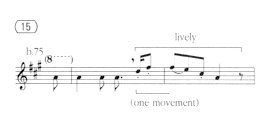
What is even more interesting
is that this constructive line is not even broken after bar 80: Toscanini
explodes the forte-dynamics with sudden force (subito technique),
and thus the statically-stiffening E-major ‘column’ can only fulfill the
part of a noun (bar 82).
In the fortissimo
form of the main theme, Toscanini now connects larger units (he precisely
draws the 4+4 bar borderline by cutting the b-motif-ending note
in the 92nd bar) and differentiates between a half-cadence and
an authentic cadence. The authentic cadence (bars 95–96) answers with the
energetic braking of the tempo to the more vigorous rhythm
of the half-cadence (bars 91–92), for which the analogous turn of the recapitulation
provides an example: the heavily rhythmic bars 284–285, where the leaden
weight of the brass and percussion ends the chase. The immediate task of
this broadening of the tempo is to make its point of support a pillar
of form for the steep heightening that follows out of it:

(We must note that the notes
of the melody are not joined as triplets in motivic unity, but rather according
to the style of the previous sketch, and as we see, every repetition of
the motive climbs higher on the dynamic ladder.)
The dynamic structure of
bars 89–96 can be traced back almost naturally to the laws of attraction
as described in connection with the themes of Haydn:

For Toscanini, the score
is a dramatic scene. The events that closely follow upon each other obey
not the rules of form, but the particular laws of dramaturgy. (In the exposition
of the movement, for instance, we cannot even find a trace of the conventional
main theme-secondary theme-ending theme order.) The earlier compression
(exposition: bars 105–108) was accompanied by a violent agitato and acceleration,
but this time it does not lead to a stop (as in bar 88), but rather ends
in a crisis.
Toscanini dramatizes the
course of the conflict with his nearly sensational tools. It was not for
nothing that he was a theater conductor – he knows the psychology of excitement
and the function of the stage: the crisis signifies the medium through
which the development is made possible. In the middle of bar 110, which
according to the score is still fortissimo, he hits upon the source of
the crisis in the alarming stroke of the timpani. The suffocating excitement
of the next bars comes as a reaction to the alarming stroke. From here
stems the staggered rhythm, the square, choked galloping of the string
accompaniment (the panting caesura after the first quarter of every bar),
and last but not least, the rapid changes of the keys that are seemingly
‘unable to find their place’. (In the recapitulation, it proceeds in a
similar manner: the b-a-g# closing notes of bar 325 step aside in
fright with a subito diminuendo at the forceful drumming of the timpani.)
Conventional performances,
however, do not in the least reflect this commotion, although according
to the meaning of the frequent key changes, the staggered dynamics and
the abrupt motif, one could also conclude this. This difference of opinion
is even more flagrant at the climax. After an unsuccessful attempt (bar
115), bar 119 finally succeeds in heating it up. How could
it have happened, that from this melody, which in the opinion of formal
analyses is ‘insignificant material’, he liberates dance movements that
have elemental effects?
The counter-rhythm of bar
119 17) – the conflict fanning ta-ti
ta-ti ti-ta rhythm – is interpreted by most conductors as a resolution:

It is not so with Toscanini:
he sharply accents both notes of the ti-ta counter-rhythm
at the end of the motive 18). Thus the polarized
tension becomes active and liberates the elemental energies that are latent
in the rhythm:

For this reason, the above-mentioned
part is neither the supplement nor the epilogue of the main theme – that
is, it does not fulfill the task of rounding-off the form, as we are usually
accustomed to – but rather crowns, or brings the theme to its peak.
(In bars 112–118, Beethoven placed the ‘ta-ti’ galloping rhythm in the
forefront, so that he can realize this burst of activity with the ‘ti-ta’
counter-rhythm.) Moreover, the tension quickly becomes charged,
which shows itself in that the counter-rhythm pushes out every other element
and becomes independent (from bar 124 onwards it repeats 8 times):

Under Toscanini’s baton,
this music is indeed lightning (he makes the rhythmic patterns in the 2nd
and 4th bars flash more quickly). Nothing characterizes Toscanini’s
way of thinking better than the fact that bar 128 starts from this condensed
rhythmic tension, and not from that external fact, that in bar 130, he
glimpses a ‘new theme’ (certain guides believe it to be the secondary theme).
The immense blocks of chords at the climax crash down upon the sforzando,
which is resolved by the sigh ‘of relief’ of the woodwinds.
Toscanini sets this ‘solution’
in the mid-point of the construction of the exposition. Let us stay
at this point for a while. The post-romantic performance style only attributes
direct effectiveness to the ‘active’ actions. The performer unceasingly
strives to go somewhere – even in moments of calm and resolution, his facial
features distort in spasms of ‘active’ enjoyment, and he therefore cannot
recognize the finest fruits of his exertion – the value of those short
moments and the lawful joy that accompanies the quenching of the tension.
A romantically inclined artist wants to actively impress, seduce and thaw,
even with the resolution. Toscanini wants to redeem with the resolution:
he wishes to free from the weight of the tension, to unlock the shackles
of the spasm, and to soften and put out the fire of anguish. He does not
accomplish this with active deeds, but rather the opposite – with inactivity,
loosening, relaxation of the muscles and an end to the gripping. That is,
he does this with some sort of negative force, that nevertheless, stronger
than any activity, reaches the deepest roots of our physical and spiritual
existence, because it effects our familiar innermost being as the untamed,
natural reflex of existence. I confess that on my part, never has any type
of performance created so much joy as Toscanini’s ‘resolutions’.
This is the significance
of the easing sigh and dolce that accompany the ‘e’ solution of b.130 19).
Afterwards, the released melody signals only a weak recovery (Toscanini
did not preserve anything from the sharp rhythms or pulsations of the main
theme, which he gradually softens into an almost ‘ta-titi’ throbbing).
This fluttering turn is primarily produced by the joy felt concerning the
solution:
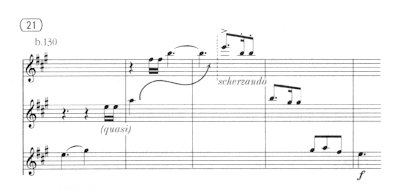
Only the scherzando of bars
132–133 answers somewhat more rhythmically, no doubt because it can return
to the ‘e’ (bars 134 forte). That Beethoven did not intend this to be a
secondary theme (at most a transition), is evident because he opens the
motive unaccented, in the middle of the bar. This picture is only broken
apart by the bold change of keys in bar 136 (E major to C major). The theme
returns with the stress of the bar, takes a firm stand, straightens itself
vigorously, and announces the greatest event of the exposition.
While we are on this subject,
let me add a personal anecdote. For a long time, I believed the weaving
of the motive in the opening movement of the Ninth Symphony to have a loose,
fantasy-like form – the pathless line of the melody sometimes popping up,
sometimes diminishing in fog and sometimes waving up and down as if in
a vision. Later when I became acquainted with Toscanini’s interpretation,
what had seemed to be an unfathomable tangle revealed itself with such
a concentration of creative logic that, with a sudden force, it provided
me with the key of the form’s construction. Toscanini puts the two choral-bars
– their sensuous, rainbow-colored string resonances – that appear in the
middle of the exposition in front of us with such complete beauty and harmony,
that, acting like a watershed, they cut the exposition into two
parts. Everything that previously was fight, struggle and strain
becomes fulfilled after these two bars.

Such a watershed divides
the exposition of the Seventh Symphony into two as well (bar 142).
It is a watershed not only between two worlds, but also between two fundamentally
opposite modes of perception. What has happened so far was
‘expression’, which took place because we wanted it, and the communicative
desire was within us, tensing in our muscles. What is revealed here
is ‘impressions’ – the magic of sound captures us from the outside,
and the floating sensation elevates us above ourselves. As if they had
changed the instruments of the orchestra, thus do the sounds begin to vibrate
and shudder. The glory of the colors – the ‘beautiful harmony’, which conventional
artistry places on a pedestal in a self-centered way, is only a tool in
the hands of Toscanini – a tool of expression and creation of structure.
When time comes for him to show the power of his baton, we are forced to
believe that ‘miracles’ are possible.
The pianissimo, like a light
maelstrom, appears above our heads (bar 142), and an excitement of spring
perfumes trembles in the tremolos. The technique that creates this magic
is built on the fairylike vibration and space-effect of the 2nd
and 4th bars. Toscanini glimpses the impressionistic painting
possibilities in the instrumental answers of bars 143 and 145, and, with
the help of the shifting of the violins, holds back the intonation of these
two bars like an ethereal echo (bars 143, 145). He makes us feel
with sensual excitement that this light floating, and this sensuous magic
are indeed the forerunners of the fulfilling explosions in bar 152 20).
We can already observe that
on the peak before the watershed (bars 119–124), the ‘active elements’
of the main theme claimed leadership, while after the watershed
(bars 142–151), Beethoven allows those components of the main theme to
prevail in the impressionistic picture, which represent the picturesque
21)
element:
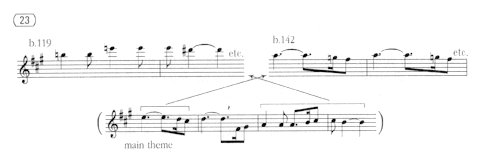
In summary: before the watershed,
the crisis is triggered from the dynamics of the inner emotions, while
beyond the watershed, the external beautiful harmony dominates and
leads to the culmination.
Toscanini realizes the culmination
of form and content of the exposition with unparalleled perspicacity.
In conventional performances, the motif generally goes unnoticed, because
the conductor places the rhythmic explosions into the focus of the heightening
(bar 152), and the motif itself is placed in the shadows. If we regard
the rhythmic explosions as mere reflectors, whose function is to lighten
the culmination itself, however, then we immediately realize that
this motive is none other than the opening theme of the symphony:
the emotionally enlarged version of the signature theme.
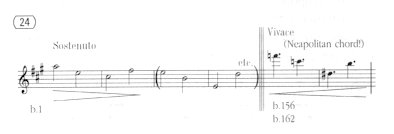
The material of the slow
and fast parts of the movement are thus incorporated into one arch by the
two motifs 22) (and so the dynamic
drawing of the signature-theme will have new light shed on it). But how
does this reflector work?

The blinding light intensity
is fed by the polar energy that is created between the inner tension of
the above accents (‘inner crescendo’). The same accent relations are taking
care of the fortissimo’s sudden interruption. In other words, Toscanini
energetically accents the last member of the rhythmic pattern, then
suddenly interrupts the process. Thus the explosion creates a ‘vacuum’
and, through the cracks, pushes the motive of fulfillment with unstoppable
force. Toscanini again was faithful to the score, since the rhythmic motive
should have been finished in such a manner:

Beethoven, however, tears
off the ending note and leaves only this from the formula 23):

What comes after this – the
dual-theme, rhythmicized with heroic freshness (a canon from bar 164) –
already confirms the safety and the final arrival. The performance accordingly
strives for maximum clarity of the material 24).
As we mentioned, Toscanini
builds up the exposition from the two opposite (both in material and tone)
components of the form. While the ti-ta counter-rhythm, which is
repeated 8-times, determines the boundaries of the end of the first part,
much like an ostinato, the ta-ti base-rhythm at the end of the second
part, which is also repeated 8-times, attains exclusive, absolute domination:
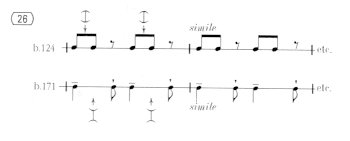
Toscanini outlines all this
even more radically with the shortening of the ‘iambs’ (as we said: with
flashes), or rather by the expansion and rhythmical overstraining of the
‘trochees’. (The protracted fourths of bars 171–178 snap away in sharp
staccato notes; the last eighth, at the end of bar 174, receives a murderous
accent.) With this procedure, he makes us aware of the fact that the overall
structure of the exposition also follows the construction of the main
theme:

***********************
It would almost require a
separate chapter for us to discuss the dramatization of the recapitulation’s
main theme, which here first appears as fortissimo, and only afterwards
as piano (bars 278 and 301). The currents that work in the intonation in
all cases give evidence of a consciousness of performance: the maestro
stresses just those elements that cause the two parts – the fortissimo
and the pianissimo blocks – to functionally complete each other. His fortissimo
motive points forward passionately, thus leading Toscanini now to
stretch out towards new effects – ones that have not yet been applied in
the exposition. He ‘hurls down’ the motive endings in the heat of passion:
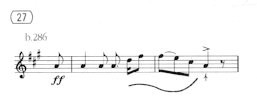
Whereas from bar 310, he
reverses the motive’s dynamic ‘cape’ 25):

As we see, he also adds to
the effect with echo-interactions (the bassoon and oboe reply to the clarinet
with echoes in bars 315 and 317).
If we wished to measure the
volume relations on the basis of the ‘density’ of dynamics, then the fortissimo
block of bars 278–299 would certainly determine the location of the center
of gravity of the movement. (With Toscanini, this is genuine ‘heavy cavalry’,
or at least a precursor to the ride of the Valkyrie.) It is exactly this
that gives exceptional meaning to the metamorphosis (after bar 300),
for there is always something moving when we succeed in spying upon one
normally known for his energetic, unapproachable greatness, in one of his
gentle, intimate moments. The suddenly emotional moods of Beethoven, Bartók
and Toscanini strike deeper than those of Petrarch, Werther or Wagner,
because they always firmly opposed sensual temptation. If the fortissimo-block
was the center of gravity of the movement, then the metamorphosis after
bar 300 leads to the subtlest display of the performance. A delicate
smile flutters along bars 309 to 318. Let us think of the airily breakable
(the ‘coming up with gentle caresses’) dolce sound and the murmuring ‘endearing
turns’ of the instruments that receive their musical shape in the previously
mentioned softening and breath-like echoes. Let us not forget for a moment,
however, that only the polar organization of the material justifies
Toscanini in this sensuous melting.
The dolce intonation is already
present from bar 301, and the theme-heads of bars 301–302–303 become a
little dreamy, later escaping into a delicate scherzando:

This time, Beethoven himself
makes the active elements of the theme disappear (he covers them up
with the upper voice), and also creates the upper voice from the material
of the first bar.
What I would like to speak
about at this time is one single chord. Between the already analyzed two
parts (the forward-moving fortissimo and the withdrawing piano blocks),
at the sudden stop – like at the meeting point of two lines of force –
there stands a quiet chord: a frozen, unmoving wind-chord. I still cannot
find an explanation for the shock created by this dead chord (bar 300).
The chord expresses with staggering suggestivity that we have stepped into
a ‘no-man’s land’ between two worlds.
***********************
The formation of the development
into an action is no small dramatic task in the organization of the material.
Here as well we can find that bridge, that makes the meaning of the world
suddenly change after we cross it. This metamorphosis, however (in comparison
to the exposition) happens in the reverse direction. If allowed, I would
call this turning point the ‘rainbow bridge’, which not only indicates
the center of the middle part of the movement, but the most daring distance
from the A major tonality of the work: Db
major and F major
together with the A major create an augmented third relationship. The prismatic
diffraction of their direct linking becomes the most unexpected harmonic
happening of the movement. It turns this rainbow game into an intangible
and delusive reflex of distance, that gives a necessary new turn to the
happenings.

If we now look right and
left from the central point, not only do the symmetries of the development
take shape in front of us, but the concept of opposition of content
hidden in the symmetries is revealed (and once again hits us with the force
of discovery).
In both the first and the
second halves of the development, Toscanini puts the shrill screaming of
the winds in the center of his construction (the ‘basic rhythm’ stripped
down to a formula). While the – in melodical sense – stiff clamor
of bars 205–206, 211–212 and 217–219 describes above all painting, color,
fresco, and molten sound-pictures, the galloping vision of bars 254–267
grabs us with the force of motion, action, doings and dynamics. In other
words, the first half of the development is occupied by static elements
(repetition of sound). The second half, on the contrary, releases active
elements. Everything that occurs in the course of the development is in
the service of this dual structural plan.
First, let us ask how we
could prove the solidity, the static strength, and the capacity of an object.
Without a doubt, we must load it with counterweights. Toscanini
indeed uses this ‘loading test’ on the thematic material of bars 201–219.
The ecstatic stiffness of the clamor of the winds is being counterbalanced
by the ‘crushing rocks’ of the strings and timpani. Thus, this transitionless
change from plunging to motionlessness happens almost against the force
of gravity, and like a natural reaction (almost a thermal reaction), heats
up the color of the winds to such a clamor.
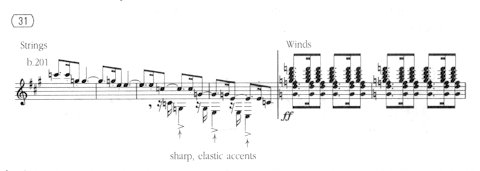
I look back on these few
bars as one of my earliest experiences with Toscanini. After the dizzying
free fall with the elastic accents into the deep, the clamor of the wind
instruments follows with such abruptness (I would like to say, with a lightning-like
straightening of the listener’s back), that perhaps I am not going too
far in speaking of an ecstatic, rhythmic trance, inasmuch as the stiffness
signifies the extreme degree of unconsciousness, or the concentrated state
of hypnosis 26). This fanatical ostinato-ecstasy
is none other than the abstract and stiffened form, rhythmicized on one
note, of the formula of the movement’s and work’s basic motion.
What is perhaps an even more
exciting task than this is a comparison of bars 217–219 and 250–253, since
the technical solutions in both are based on alternating answers between
the strings and wind-instruments – but with what diametrically opposing
meaning of content!
In the first case, we stand
directly in front of the ‘rainbow-bridge’ that links the two sides of the
development (bars 217–219). Let us imagine the argumentative dialogue as
if the strings and the winds were to position themselves on duplicate stages.
Toscanini creates this effect by sharply cutting off the ending note of
the strings, without any reverberations, compelling the listener to pay
attention to ‘space’. Thus the answer of the winds can strike back now
from ‘beyond’. The score most effectively justifies Toscanini’s interpretation.
The spatial effect – the idea of ‘here’ and ‘beyond’ – ties together the
c#
of
the strings and the f of the winds, in the same manner as the rainbow
bridge also leads from c# to f, connecting this bank with
the other:
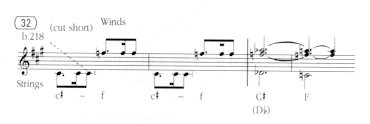
Suitably for the symmetrical
structural plan, we encounter the alternating answering once again in the
second half of the development. In contrast to the earlier acoustical
meaning of the string-wind reflexes, bars 250–253 drive the most mobile
desire for action. The wind instruments no longer echo the strings,
but on the contrary, they passionately stand out beyond the strings:

In the glittering game of
bars 222–235, perhaps because here we arrive at the middle point of the
development, a countercurrent flows between the wind and string parts.
Above, in the theme of the winds, the melody head becomes always
sharper in pattern and the closing notes become devoid of tension, while
below, the opening bars of the string voices are more loosely woven
and the closing member becomes more active and more personal:
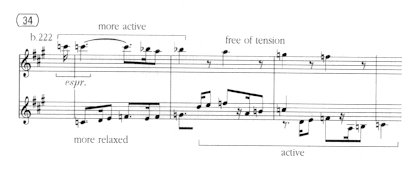
At the beginning of this
study we almost unintentionally exposed the symmetrical correlation between
bars 195–200 and 236–249 (cf. Fig. 6). Now we can at
most observe in surprise that all of the repetitions of notes in
bars 195–200, and all of the mobile voices of bars 236–249 fit into
the polarized plan with self-evident and natural logic:
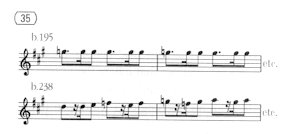
The forward-swinging of the
bars that lead to the recapitulation (from bar 268) is caused by the sharper
rhythm of the two notes at the end of the bar:
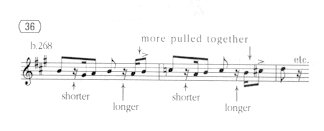
and the momentum of these
carries also the pulsation of bars 274–277 further ahead 27):

Finally, let us take a glance
at the coda. With the help of the maestro, here we arrive closest
to the genesis of the basic elements of the main theme. Perhaps it is not
necessary to prove that this time the steepest ascent of the movement has
to become reality and the power of the wild heightening can only be increased
if we arrive at it from a resting point. As a result of this,
the components of the theme create new relationships with each other. I
would characterize in short the form as thesis, antithesis and synthesis;
that is, the passive pictorial elements of the theme as thesis,
then the active, mobile elements of the theme as antithesis, and
finally, at the climax, the two together.
The exclusive building blocks
of the first part (391–400) are the three opening notes of the main theme.
The compositional technique here is based on the interplay of colors, full
of refraction of light and ‘distuning’. The harmonic connection, that in
the case of the above-mentioned rainbow bridge was a one-time surprise,
here becomes a law (major triads related to major thirds overlap each other:
A b
and C major, F and A major; in addition, A
b
major and C major have an augmented third relationship with the expected
dominant E). Toscanini’s palette of colors was perhaps only this airy,
and so translucent at bar 309. The melodic arches, the echoes and reflexes
step out of the impressionistic painting in such a manner that where
they came from is not even determinable. Each melodic arch advances towards
‘openness’ (the notes reveal themselves almost with the logic of the sordino
opening of a wind instrument) 28):

We will later return to the
role of this effect in form. From bar 393, the first violins always answer
the questions of the second violins in a gentle echo. Toscanini ‘snatches’
the pianissimos at the end of bars 397 and 400 (bitten-off Puck-like
chuckles) with a refined irony. Thus these barely audible, hidden rejoicings
become the point of the melody…
Finally, the highest lightness:
the arches of bars 398–400 that slip away into sparkles, or rather, their
‘fragrances’, which dissolve the melody into pure colors, the harmony in
refraction of air, and the line with volatile optical apparition. All of
this Toscanini, with his spiritual outlook, renders as a unique and unrepeatable
‘visual’ event, the deeper meaning of which is eventually given by the
chromatics of the bass ostinato, peeping in the darkness (from bar 401).
The dramatic seed of the
active
second member of the coda is the obstinate opposition of the two parts.
The initiative is first taken by the serpentine bass, but from bar 415,
a tangible change steps in, so that eventually, the upper voices of bar
423 break into a triumphal exultation. The course of the struggle, from
the dark beginning to the achievement of victory, is confined by the balance
of power between the opposing voices. The technical realization of this
intensification would be impossible without the immediate, or rather the
most immediate, interaction of the violins and basses. It is only in the
frame of this ‘dual theme’ that there are grounds for the soaring of the
violin crescendo in bar 404 as well as for the first motion of breaking
through which occurs four bars later 29):

The crescendo, or let us
call it the charging of the form’s battery, is also fostered by the outermost
voices: at the positive pole, with the ‘trochee’ base rhythm of the violins,
and in the negative bass-pole, with the conflict-stirring ‘iambic’ counter-rhythm.
The outcome of the battle, however, is only decided by the last one and
a half bars. At the end of bar 421, the timpani ‘explodes’ through the
orchestra (we encounter a similar impulsive effect perhaps only in Klemperer’s
recordings) and frees the fanfare-motive to the surface. How characteristic
of Toscanini that he is able to increase even the effectiveness of these
fortissimo chordal blocks with the help of the more throbbing, more sharply
edged rhythms of the even bars (bars 424 and 426).
Here already, the interjections
take the lead. The relationship between the short caesura and accent as
shown below becomes more aggravated in the stamping of bars 433–437:

so that the third member
of the coda, and at the same time its synthesis, can burst out from
this. In the first member (in the pictorially composed bars 393–400) the
exclusive thematic material was the motif, that we considered as the ‘subject’
of the main theme. Contrastingly, the second member (the tense bass-ostinato
of bars 401–420) is driven by the motif and rhythm that was the mover of
the ‘predicate’ of the main theme:

(To all this, Toscanini’s
sound-fantasy adds the most crucial characteristic: both motifs reach the
middle of the bar with a crescendo, but while the first case goes from
a closed intonation towards an open one – that is, it was an expansion
–, the bass-motif stretches the muscles of the structure, as if it ‘compressed’
the intonation).
After the two analyzed parts
– the thesis and the antithesis – bar 442 achieves synthesis on the account
of the ‘subject-predicate’ relationship. With the raw confrontation of
the two elements, in the coincidence of the ‘visibly sensuous’ and the
‘wilfully active’ worlds, Toscanini increases the dual function of the
thematic material to almost super-human proportions. He introduces the
melodic
and rhythmic elements in the middle of the brawl; on the one side
with a high-crying horn-wind call, and on the other side with the violently
interrupting timpani:

The inclination of the ‘singing’
element to expand and the moving force of the ‘active’ element increase
towards ecstasy. While the melody stridently overpowers the wilful rhythm,
the rhythm endeavors to rebuff the overflowing colors of the melody.
The capability to summarize
the basic elements as well as the capability for such a degree of concentration
of the material out of which experiences are made – the truly Michelangelo-like
features in Toscanini’s art – led Aladár Tóth 30)
to think of these ‘marble blocks’ when he saluted him as the successor
of the great renaissance Italians.
(The grim static character
of the two closing bars not only puts an end to the movement, but also
gives an initiative for the change to the suffering minor key of the Allegretto.)
Was there another among the
orchestral artists of this century who could have felt the laws of musical
dialectics so unerringly, with an almost impersonal security in his cells
and nerves? Toscanini’s recording of the Missa Solemnis made me
suddenly aware that this artist really cannot say two ‘credos’ or ‘pacems’
one after another without the first reflecting a tense motion of
skepticism, and the second reflecting unshakeable belief and affirmation.

Perhaps it is this simultaneous
negation and affirmation that opens his way to the rediscovery of Beethoven.
2) Usually
a peak note or a tense ‘subdominant degree’ (the 4th or 6th degrees of
the scale).
3) This
is even more palpably evident in the 1936 recording.
4) Fundamentally,
bars 3–4 follow the course of the first two, with the difference that (as
a result of the previously mentioned principle) the oboe’s melody of the
4th bar becomes more sensitive, its fourths being warmed by gentle tenutos.
5) Harmonically,
this is also a breakwater: note the appearance of the tension in the subdominant.
Toscanini unmistakable warns us through the elongation of the two eighths
at the end of bar 6 that a climax will follow.
6) Increasingly
lengthened quarter notes.
7) “Ew’ges
Ur-Vergessen” (Wagner: Tristan and Isolde, Act III)
8) That
is, he increases the strength and value of the experience by allowing the
fulfillment to last a short time only. Toscanini makes clear with unrivalled
security that something ‘has begun’ at the end of bar 9. (cf. Fig. 10).
The threefold scalar steps of bars 10–12–14 represent three degrees. The
playful excitement of bar 10 is expressed through its light staccatos,
on every quarter accent, that are elongated by tiny joyful hiccups. A certain
amount of tension is mixed into bar 12 by the repeated c# exposed in the
beginning of the measure. Toscanini already brings larger units together:

Finally, the stretched
third degree reverses the dynamics, and whether one likes it or not, drags
the listener by the hair along with it:

From bar 15 onwards, the
monumental construction is also manifested in the clear articulation of
the thematic scheme. The beginning and end of the 8-tone scale groups are
almost palpably tangible (and with this the construction also prepares
for the rhythm of the second theme – cf. bars 24 and 26–28.):

particularly from bar
18, since the earlier bars are still under the dynamic sway of the volcanic
eruption.
9) If
the main theme’s pulsation lives in common knowledge as having a ‘twittering’
rhythm, then here, with a similar play on words, one could say:

10)
Beethoven himself makes use of this relation in bars 32–34 in order to
join the two themes together.
11)
The aforementioned ‘punchline’ of the melody finds its place in the structure
by falling on an even measure. This is why the playful scale of
bar 22 was already so lithely active (Toscanini moves the two and four
quarter groups more animatedly). Let us add to this, that he gently lets
the two eighths at the end of the passive bars (23, 25) go, so that he
can start bars 24 and 26 with a tense tenuto.
12)
Thus a peculiar duality arises between the melody and the accompanying
ostinato.
13)
Toscanini happily mentioned that he received his first lesson with respect
to this from Verdi himself, who at the rehearsal for Otello drew
the attention of Toscanini, who was sitting in the cello section
to this: what is such a pianissimo worth that cannot be heard? The pianissimo
expresses character and not volume!
14)
In old music, this phrase did not only mark repeated notes, but also the
dominant of the key.
15)
The violin and flute change places with each other: the flute-signals go
to the beginning of the measure.
16)
Bars 42–52 only differ from the earlier interpretation of the theme, in
that Toscanini holds the melody together better. While the tense g#
of bar 54 and the even tenser b note intonate the melody (so that
the picture can burst open with the fp of the next measure), the
same melodic turn is treated as a passive element in bar 56.
17)
It is enough to quote the opening movement of the Eroica to illustrate
what a lively role the complementary rhythms play in Beethoven’s thought
processes:

cf. further with bars
201–206 from movement III of Seventh Symphony.
18)
This holds even truer for bars 331–339 of the recapitulation.
19)
It is impossible for me to refrain from adding an analogous example: The
unforgettable introductory bars of Toscanini’s recording of Missa Solemnis.
The secret of the effect here too lies in the resolution – in the liberation
from the weight of the tension – this is expressed in the low, satisfying
sigh of bar 6:

(Beethoven’s own notes
point to such a meaning, for we can read such remarks as ‘durchaus simpel’
and ‘les derniers soupirs’ in his sketch-book, at this and similar turns).
20)
The heightening in the exposition is somewhat more impatient than in the
recapitulation. The hastened accent-points of bars 358–360, as will soon
become clear, will reveal something of vital importance about the motive
itself and its inner dynamics:

21)
I adapted this terminology from the Bach-analyses of Albert Schweitzer.
22)
At the other ‘key-point’ of the exposition, in bars 126–127, a similar
motivic structure appears:

23)
In the recapitulation, this rhythm is even more forceful (bars 364–373).
24)
For instance the violin part of bars 166–167 – in accordance with the score
– does not use sforzandos, so as to make room for the bass theme. The resolutions
of the exposition and the recapitulation are slightly different from each
other. The following motive

in the case of the recapitulation,
closes the theme with resolute motion, signaling that the work has come
to a resolution. In the exposition that same motive is less assertive,
and rather permits the imitating bass to assert itself, since the development
still lies before us.
25)
Unsurpassed sweetness emanates from the separate beginnings of the two
staccato notes at the end of bars 309 and 311 (as it also does from the
piano-pianissimo of the oboe melody in bar 317).
26)
Cf. Ortega: Sketches on Love (Love, ecstasy, hypnosis).
27)
That is to say, Toscanini carries the metrical tension forward to the middle
of the bar. He unexpectedly slows the tempo of bar 277, and seizes the
middle of the bar, as an up-beat of the main theme, with an even more powerful
motion. The same thing also occurred in the analogous place – in the middle
of bar 66.
28)
Only the very first motif (bar 393) sounds out in a more pronounced fashion.
29)
Here Beethoven specifies the first staccato and rest in this crescendo
part. This is why Toscanini adheres to the unshaded legatissimo of the
score in the violin parts of bars 401–402 and 405–406. If we have already
examined the c#-b-a turn of bar 400 and the c#-b-a
turn of bar 408 separately, let us mention that Toscanini, precisely with
the help of this c#-b-a rhyme, also illuminates the
existing relation between the contents of the two.
30)
Musicologist, famous Hungarian musical critic (1898-1968), [transl.]
Contents
|